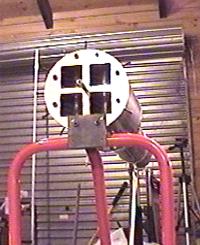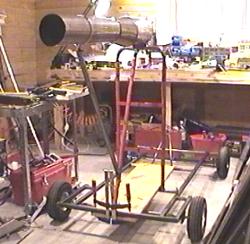Last updated 22 February, 2001
|
UPDATE: 100lbs-thrust engine added and first hi-power ride taken -- details and new pictures
at the bottom of this page
Testing The Chasis So... I grabbed one of my midi-sized pulse-jets (about 30 lbs thrust) and bolted it to the side of the kart. As I mentioned -- the kart doesn't even have a seat yet so I clamped a piece of wood onto two cross-members to stop my backside from scraping along the cement. This board was also a handly place to lash the 20lb propane tank which provides the fuel for this jet.
Now I have an uncompleted, but pulse jet powered, kart! However, after going to all this trouble I discovered that my propane tank is so close to empty that I can't get enough pressure to run the engine up to full power. So here it is -- the "I cant wait, pre-turbine" version with comfortable wooden plank seating and near-empty fuel-tank.


Update -- It moves!
Since I don't have any brakes yet, and 10 mph is more than fast when the only thing separating your backside from a bumpy country road is a creaking piece of aged timber, I decided not to try for a speed record. I trundled about 300 yards down the road, did a 180 and came back. Fifteen minutes later I got a phone call from a friend who lives about a mile and a half away to say they heard my engine running -- that's nothing new, they often hear it running -- except this time they were calling from the golf club -- over three miles away! Could you ever imagine me living in the suburbs? I don't think so. Tomorrow I'll go get that propane tank filled and bolt on the "big pulse jet" which is giving about 90 lbs of thrust. And yes, because I know you're wondering -- I did burn my leg on the pulse jet pipe (damn!)
 A new kind of "burnout"
More Power! Here are some pictures taken in my now very cluttered workshop under rather glaring benchlights so they're not the best quality -- but I'm sure you'll get the idea. After having a rotisserie moment with my leg on the smaller engine when it was mounted on the kart, I decided that this time the hot bits should be mounted well out of harm's way -- so it's on top of a newly added rollbar. The observant amongst you may have noticed that this roll-bar is in fact largely made from what was left of the cheap trolley I bought in order to get the low-cost wheels I'm using. Talk about recylcing!
I still have to mount the LPG tank and run the fuel line to the front of the engine but with a little luck I'll get this done tomorrow and, if all goes well, post some video of the first road-trials. Hmmm... maybe I'll also get some loctite while I'm out tomorrow -- that big engine kicks up quite a bit of vibration and I'd hate for the mounting bolts to come loose.
Here are some more pictures of the engine as it is mounted on this kart.


So what do you think... am I crazy or what? Just added: MORE pictures of the Jet Kart
UPDATE: Road-tested With 100lbs-Thrust Engine! As I expected, pure thrust is not the best way to power a gokart -- at least not on roads like the ones around my place. My "test track" consists of a gravel road where the straight sections are not flat and the flat sections are not straight. It's worth pointing out at this stage that I weigh about 170lbs and the kart weighs about 90lbs when ready-to-roll. This represents an all up total weight of about 260lbs (depending on how much I've just had to eat). Now, with 100lbs of thrust, that gives me a 1:2.6 power to weight ratio. While this is significantly more than your average passenger plane -- it's not as high as a jet fighter and, more importantly, it means that if I encounter a slope of more than a 1 in 2.6 gradient -- the kart will begin to slow and eventually stop. It's also worth pointing out that jet engines tend to become more efficient as their speed through the air increases. They work by propelling a narrow column of hot air at very high speeds. Think of it like top-gear in your car - plenty of speed but not much acceleration. As a result of this, the jetkart feels quite sluggish when moving away from a standing start. You can feel a gentle push moving you along but it's certainly not a "kick in the pants." However -- and this is the tricky bit -- it very much feels as if the faster you go, the harder the kart accelerates. Indeed -- once I got up to about 30 mph that gentle push had turned into quite a noticeable shove and the kart was gathering speed at quite a rate. As I said though -- the roads around here are not built for speed so I had to limit my bursts of power to the short (100 yards) between the tight corners and big dips in the road.
Just working from a "seat of the pants" feeling, I'd say that the kart is probably capable of well over 50-60 mph -- the limiting factor probably being the driver's ability to keep it going in a straight line and the lack of aerodynamics. Yes -- I discovered that the steering on my kart is "very direct" which makes keeping it going in a straight line at 30 mph on a loose surface quite a challenge -- especially considering that I don't have a foot-operated throttle but rely on turning a knob on my gas-line. It takes three full turns go from idle to full power -- and that only leaves one hand free for steering so I expect you can imagine just how exciting the first test-drive really was. Unfortunately there was nobody here to videotape the first run with the big pulsejet engine but I'll try to convince someone to stand around with a camera while it's running next time. Another problem I encountered was that the aluminum strap I used to secure the tailpipe of the engine to the kart frame just melted away. I'll have to make a new one from steel. Fuel economy? What's that? The kart consumed 4Kgs (about 10 lbs) of LPG during the 3-4 minutes I spent on the first run. That's about $2-$3 a minute in fuel costs! Now I'm going to get on with the turboshaft engine and fit that -- it should provide better fuel economy and stronger "off the line" acceleration.
|
|
 Okay, so I'm the impatient type -- as soon as I got the gokart chasis
rolling (even before the seat was fitted) I just had to put a jet engine
on it and see how it went.
Okay, so I'm the impatient type -- as soon as I got the gokart chasis
rolling (even before the seat was fitted) I just had to put a jet engine
on it and see how it went.
 The fuel lines were zip-tied to the frame and throttle control is provided
by a little nob that controls the rate of gas-flow. Very crude and only
somewhat effective as it takes about two full turns to cut off the gas supply --
meaning that if the pulse jet stops for any reason, huge flames billow out the
tailpipe while I try to turn off the gas.
The fuel lines were zip-tied to the frame and throttle control is provided
by a little nob that controls the rate of gas-flow. Very crude and only
somewhat effective as it takes about two full turns to cut off the gas supply --
meaning that if the pulse jet stops for any reason, huge flames billow out the
tailpipe while I try to turn off the gas.

 Of course I'm still using the "plank seat" but at least the roll-cage now gives
me something to rest my back against -- Ah... the comfort :-)
Of course I'm still using the "plank seat" but at least the roll-cage now gives
me something to rest my back against -- Ah... the comfort :-)
 Given the rather primitive brakes currently fitted to the kart, I expect
you can imagine my adreneline levels at this point in time.
Given the rather primitive brakes currently fitted to the kart, I expect
you can imagine my adreneline levels at this point in time.